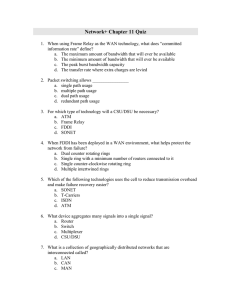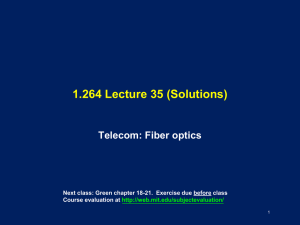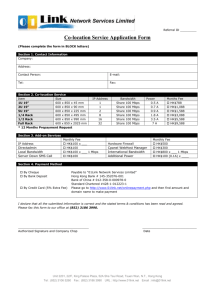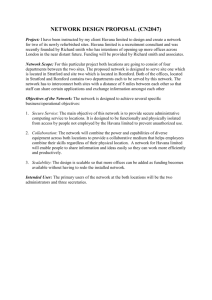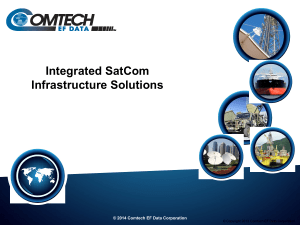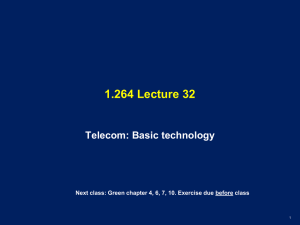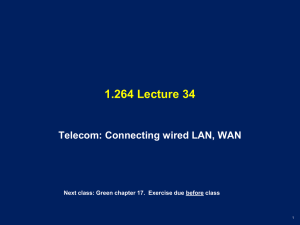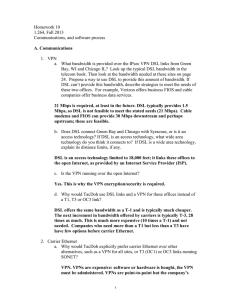1.264 Lecture 34 (Solutions) Telecom: Connecting wired LAN, WAN
advertisement
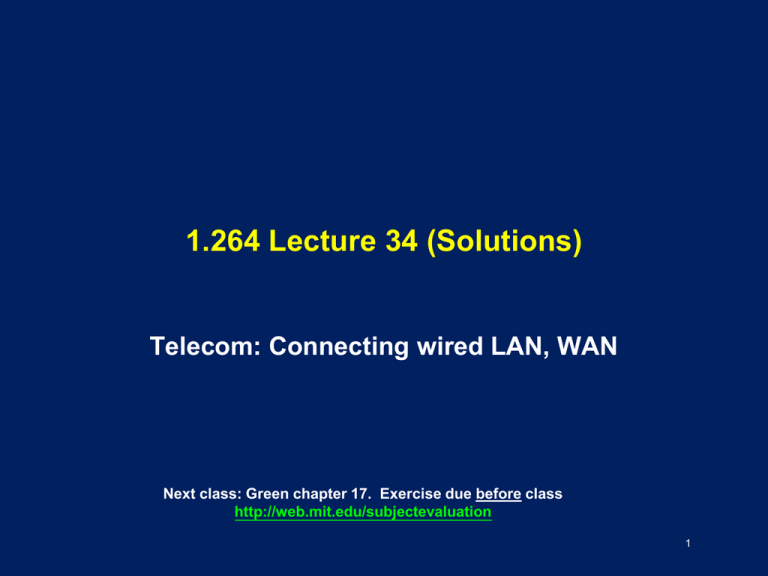
1.264 Lecture 34 (Solutions) Telecom: Connecting wired LAN, WAN Next class: Green chapter 17. Exercise due before class http://web.mit.edu/subjectevaluation 1 Exercise • Your transportation brokerage company also handles billing for freight shipments, collecting from shippers and forwarding payment to carriers. – This data must be secure; you route funds directly to banks in some cases and between customers in other cases. • How would you communicate between your three major sites in New Jersey, Houston and Los Angeles? – You transfer approximately 10,000 bills of lading in a 1 hour window at the end of each day from Houston and Los Angeles to New Jersey, which is the only site connected to banks and customers – Each bill is about 500 kB of data (documents and signatures are scanned) • Select the technology and bandwidth – Will you use LAN, WAN or MAN technology, or combination? – Which specific technologies will you use? Discuss options, pros/cons briefly. – Discuss broader options surrounding your choice. 2 Solution • Bandwidth: – – – – 500 kB x 8 bits/byte x 10 000 docs / 3600 seconds/hr Approximately 11 Mbps raw data rate Connection should be at least 15 Mbps, for overhead, etc. If we route LA traffic via Houston, Houston-NJ needs 2530 Mbps – Either case requires OC-1 (45-51 Mbps) bandwidth • Technology: WAN between LANs at each site – With only two links (LA-Houston and Houston-NJ), two point to point fiber optic links are a possible solution • Used only 1 hour a day, though… – Internet could handle it but large bursty traffic across the country would have reliability problems • Business traffic has security issues on open Internet – Satellite bandwidth too low (network video has special deal!). 3 Solution, p.2 • Business process can/must change: – Established years ago with small amount of data and expensive telecom – Cheaper to send documents in real time now – If docs sent in real time 10 hrs/day, bandwidth = 1.5Mbps, which can be handled by T1, DSL, … much less expensively. 1.5 Mbps is a sweet spot. – Or, look further: do we need to send all 500 kB to the bank? If we store the full document, can we send just the part the bank needs? Trade off complexity vs cost • Another reason why we use spiral model – Telecom considerations at the very end can require changing a business process • Which requires changing requirements among channel partners • And changes UML, database (maybe), Web services, etc. – If we find this in the first spiral, we can change it – If we find this at the end of chaos/waterfall, it can be desperate 4 Exercise: MAN LAN MAN Distance (kilometers) Owner Number of devices Bandwidth (Mbps) Resiliency/redundancy (yes/no) Is there a service level agreement (contract)? Give approximate ranges for distance, devices, bandwidth. 5 Solution LAN MAN Distance (kilometers) 1-5 km 5-50 km Owner Company/user Carrier Number of devices 10-1000 1000-100,000 Bandwidth (Mbps) 100Mbps-1 Gbit/sec 2 Mbps-10 Gbit/sec Resiliency/redundancy (yes/no) No Yes, usually Is there a service level agreement (contract)? No Yes 6 Exercise • You have a depot in an industrial area without carrier fiber optics • You have 1,000 buses that return to the depot every evening and upload video to a remote site • Each bus has 10 hours of 384 kbps video. • Data goes via WiFi (wireless LAN) from each bus to a depot server, and then to the remote server. • You want all data to transmit in 2 hours. • Choose between DSL, cable TV and 4G wireless access. Which of these 3 can handle it? – If they can’t, what do you need? 7 Solution • Data/sec= 1,000 veh * 384 kbps= 384 Mbps • Time to send= 2 hr • Time to record= 10 hr – Thus, the data must be sent 5 times as fast as it was recorded. • Bandwidth= 5 * 384 Mbps= 1920 Mbps= 1.92 Gbps • DSL, CATV or 4G/LTE cannot handle this • You need OC-48 (2.5 Gbps) over fiber to do this. – You might be better off having each bus send real time video over LTE, though it would be expensive… You could sample, have driver control it (usually), etc. 8 MIT OpenCourseWare http://ocw.mit.edu 1.264J / ESD.264J Database, Internet, and Systems Integration Technologies Fall 2013 For information about citing these materials or our Terms of Use, visit: http://ocw.mit.edu/terms.
